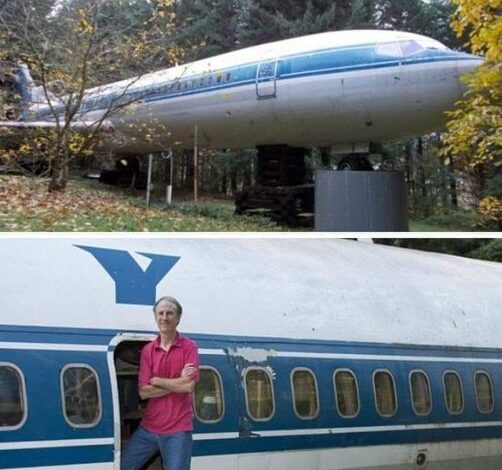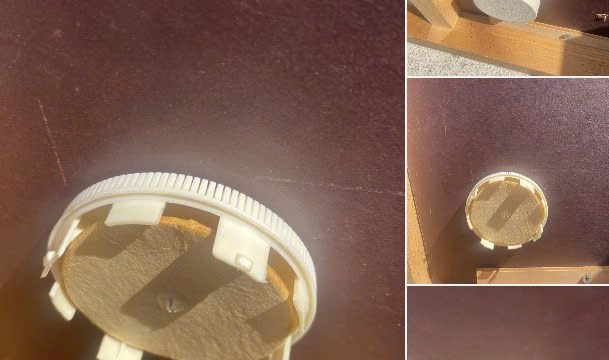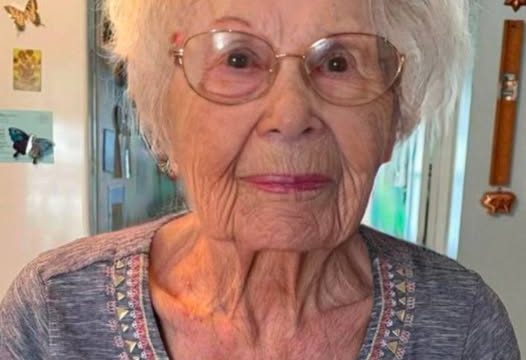Imagine living inside an airplane, transformed into a stunning and functional home. This is the extraordinary reality of 64-year-old Bruce Campbell, a retired electrical engineer with a flair for invention. Decades ago, Campbell made a bold investment in 10 wooded acres near Hillsboro, Oregon, for $23,000. Little did he know that this purchase would become the foundation for one of the most unconventional homes in the world—a retired airplane nestled amidst nature.

A Vision of Innovation
From a young age, Bruce Campbell enjoyed taking things apart and reassembling them in new and inventive ways. His creative mind led him to dream of building a unique home on his Oregon property. Initially, he planned to construct a house using a collection of retired cargo ships. It was an ambitious and unconventional idea, one that he believed was entirely original.
However, two decades after first envisioning this project, Campbell stumbled upon the story of Joanne Ussery, a hairdresser from Mississippi who had already turned a Boeing 727 into her home. After her house burned down, Ussery decided to rebuild her life in a retired plane located beside a serene river. Her story inspired Campbell, and he decided to pivot his plan. Instead of cargo ships, he would use an aircraft as the centerpiece of his home. While Ussery’s success sparked his imagination, Campbell was determined to take his vision further and personalize it to reflect his creativity.
Acquiring a Boeing 727
In 1999, Campbell set his sights on a retired Boeing 727 from Olympic Airways. Purchasing the airplane was no small feat—he paid $100,000 for the jet alone. But the challenges didn’t end there. The massive aircraft was located in Athens, Greece, and transporting it to Oregon added another layer of complexity. Moving a plane across continents and into the dense Oregon forest was an expensive and intricate process, costing an additional $120,000. By the time the plane was securely placed on his property, Campbell’s total investment in the project had reached $220,000.
Despite the high cost and logistical difficulties, Campbell never doubted the value of his investment. For him, this was more than just a home—it was a lifelong dream coming to fruition. The airplane offered a unique opportunity to create a space that was both sustainable and innovative, blending his engineering expertise with his passion for repurposing materials.
Transforming the Aircraft into a Home
Once the Boeing 727 was situated on his property, Campbell began the process of turning it into a livable space. The interior, once filled with rows of passenger seats, was stripped and redesigned to suit his needs. Campbell retained many of the plane’s original features, ensuring that the structure’s history and character remained intact.
The airplane’s cabin now serves as the central living space, with its sleek design and durable materials providing a unique aesthetic. The cockpit has been preserved, adding a touch of nostalgia and serving as a functional area for Campbell’s technical experiments. The fuselage, with its cylindrical shape and ample windows, creates a bright and airy environment that feels surprisingly spacious.
A Sustainable Approach to Living
Campbell’s airplane home is more than just a conversation starter—it’s a model of sustainability. By repurposing a retired aircraft, he has given new life to a machine that might otherwise have been scrapped. Airplanes are built to withstand extreme conditions, making them ideal for long-term use as a shelter. The aluminum fuselage, for example, is not only lightweight but also highly durable and weather-resistant, ensuring the structure remains intact for years to come.
Inside, the home is outfitted with essential amenities, including a shower, kitchen, and sleeping quarters. Campbell’s minimalist approach reflects his philosophy of living simply while embracing innovation. He has also made use of the plane’s existing systems wherever possible, showcasing the potential for adaptive reuse of industrial materials.
Challenges and Triumphs
Transforming a Boeing 727 into a home was no small undertaking. From navigating the complexities of transporting the aircraft to adapting its interior for residential use, Campbell faced numerous obstacles. However, his determination and problem-solving skills allowed him to overcome these challenges. For Campbell, the process was just as rewarding as the result, providing an opportunity to push the boundaries of traditional architecture.
Despite the initial costs and labor-intensive nature of the project, Campbell considers his airplane home a worthwhile investment. It stands as a testament to his creativity, resilience, and commitment to sustainable living.
A Legacy of Innovation
Bruce Campbell’s airplane home is a remarkable example of thinking outside the box—or, in this case, outside the house. By transforming a retired Boeing 727 into a functional and stylish living space, he has redefined what it means to repurpose materials. His story has inspired countless others to explore unconventional housing solutions, proving that with vision and determination, the possibilities are endless.
As Campbell continues to live in his airplane home, it remains a symbol of his ingenuity and passion for innovation. The blend of modern functionality and aviation history creates a space that is both practical and awe-inspiring. For Campbell, this project isn’t just about having a unique home—it’s about embracing a lifestyle that values creativity, sustainability, and individuality. His journey is a testament to the power of imagination and the rewards of pursuing a dream.





